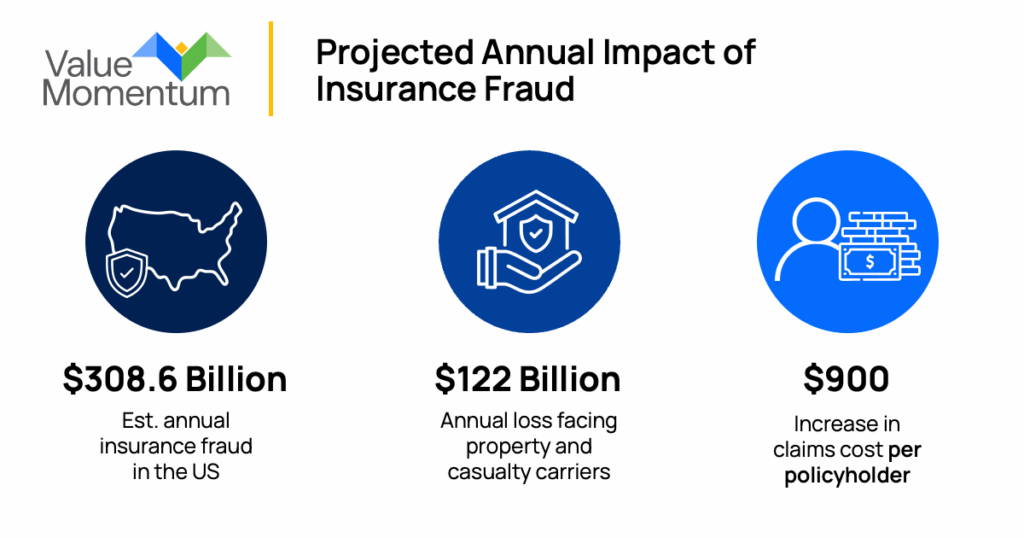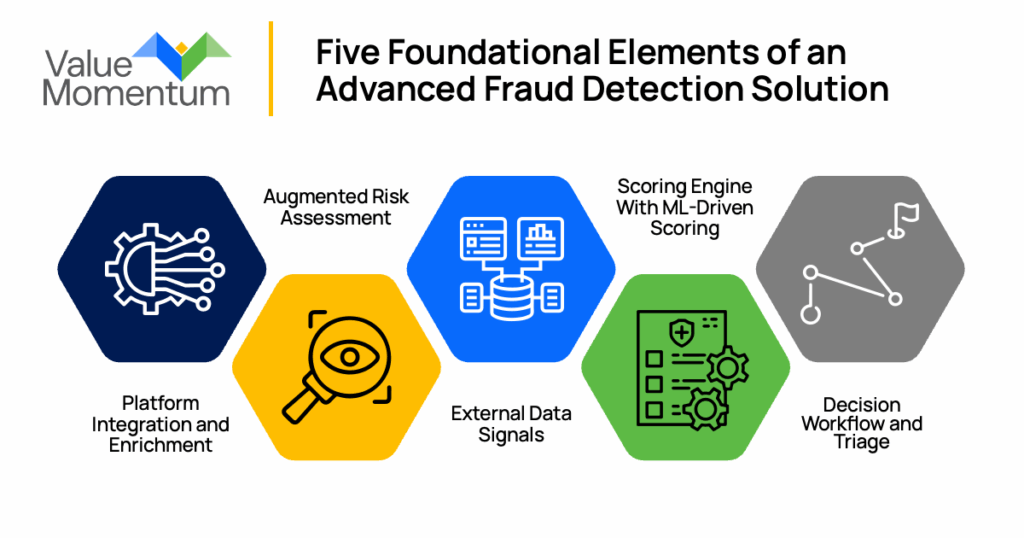Fraud in insurance not only erodes profitability, but it also increases premiums for honest policyholders and puts pressure on operational resources. In the US alone, insurance fraud is estimated to exceed $308.6 billion annually, with property and casualty (P&C) carriers facing roughly $122 billion in losses each year.
For carriers, the impact is severe: Fraudulent claims can inflate total claims costs by up to $900 more per policyholder each year if left unchecked. The challenge is clear — insurers must detect fraud early, accurately, and at scale, without slowing down legitimate claims or overburdening investigation teams. That’s where fraud detection solutions powered by artificial intelligence (AI) and machine learning (ML) deliver a game-changing advantage.

The Challenge: Rising Fraud, Outdated Solutions
Insurance fraud takes many forms — from exaggerated damages and staged accidents to identity manipulation and organized fraud rings. Traditional approaches to detecting fraud haven’t kept up with this rising complexity.
Rule-based detection systems are increasingly ineffective due to their reliance on static thresholds, which can miss emerging fraud patterns, and their potential to generate false positives for legitimate claims, leading to customer frustration. These rule-based systems also operate in silos, which can fail to integrate external signals like credit, geolocation, or network analysis and are difficult to scale alongside evolving types of fraud.
With fraud attempts rising by more than 20% year-over-year and policyholder expectations for faster, more transparent claims experiences higher than ever, investigative teams can’t afford to waste time chasing false positives or manually piecing together fragmented data. Insurers urgently need modern claims management and fraud detection solutions.
Enhancing Fraud Detection With AI and ML
AI-powered fraud detection solutions don’t just change how insurers work — they change what insurers can achieve. By embedding intelligence into every step of the claims process, carriers can stop more fraudulent activity, accelerate legitimate claims, and focus investigative resources where they matter most.
The result is a measurable shift across several critical areas:
- Lower Fraud Leakage: When multimodal capabilities that use AI are applied, insurers could cut fraud-related losses by 20-40%, depending on their implementation strategy and the complexity of their fraud environment.
- Optimized Investigations: By automatically triaging claims, Special Investigations Units (SIUs) can concentrate on high-risk cases, improving resolution rates and freeing investigators from low-value manual reviews.
- Faster Claims Processing and Better Customer Experience: Low-risk claims can move quickly through straight-through processing, while suspicious ones are intercepted early. This dual approach accelerates cycle times and helps carriers deliver on customer expectations for speed and transparency.
- Reduced False Positives and Operational Costs: AI models improve accuracy by learning from patterns across structured and unstructured data. By reducing false positives, insurers avoid wasting SIU resources on legitimate claims and ensure customers experience fewer delays.
- Improved Compliance and Transparency: Explainable scoring models provide regulators with a clear audit trail, helping carriers meet compliance obligations while preserving trust.
Fraud is one of the industry’s largest sources of leakage. Deploying modern fraud detection solutions is not just a defensive measure — it’s a way to improve combined ratios, unlock millions in annual savings, and strengthen customer relationships through faster, more transparent claims handling.
Critical Components of Advanced Fraud Detection Solutions
By combining advanced analytics, external data, and human expertise into one framework, insurers can go beyond the limits of rule-based detection to identify fraud earlier, reduce false positives, and streamline legitimate claims. The fraud detection solutions of the future are adaptive and integrated across the entire insurance life cycle.
Here are five foundational elements of an advanced fraud detection solution:

- Platform Integration and Enrichment
Fraud detection is most effective when it’s built directly into the claims workflow, not layered on afterward. By connecting seamlessly with claims systems and orchestrating data across internal and external sources, insurers reduce friction and ensure every claim is screened consistently. The urgency to modernize is clear: the market for insurance fraud detection technology is projected to grow from $4 billion in 2023 to over US $32 billion by 2032, reflecting how central seamless integration has become. - Augmented Risk Assessment
Each claim is evaluated from multiple angles: rules catch known red flags, ML models analyze both structured and unstructured data, and the special investigations unit (SIU) provides continuous feedback to improve the system. This multi-layered approach allows insurers to spot fraud much earlier. In fact, ML models have been shown to flag suspicious claims up to two weeks after first notice of loss, well ahead of traditional methods. - External Data Signals
Internal claims data only tells part of the story. AI-powered solutions integrate external inputs — such as ISO ClaimSearch, credit bureaus, geolocation, and even network and graph analysis — to connect the dots across multiple claims. This enrichment reduces wasted investigations and minimizes false positives, which are a major pain point for insurers and customers alike. - Scoring Engine With ML-Driven Scoring
All signals are combined into a scoring engine that generates overall and category-specific risk scores (e.g., behavioral, financial, network, etc.). Because the models learn continuously, scoring becomes more precise over time while remaining transparent enough to meet regulatory requirements. With fraud attempts rising and technology adoption accelerating, static rules engines simply cannot scale to meet the demands of tomorrow’s fraud environment. - Decision Workflow and Triage
Based on these scores, claims are routed into the right workflow: high-risk cases sent to SIU, medium-risk flagged for manual review, and low-risk processed straight through if no additional red flags exist. This targeted triage ensures resources are focused where they deliver the most value. For example, agentic-AI-enabled workflows reduce manual investigation workloads and help carriers identify suspicious activity sooner, supporting both cost efficiency and better customer outcomes.
By combining these five foundational elements, insurers can create fraud detection solutions that not only respond to schemes but also anticipate them. Machine learning continuously sharpens detection accuracy, reduces false positives, and ensures faster, fairer outcomes for policyholders.
Winning the Fight Against Fraud
Fraud will always be a challenge, but the way carriers combat it is evolving. Static rules and manual reviews can’t keep pace with sophisticated schemes or with policyholders’ expectations for fast, transparent claims. By embedding AI-powered fraud detection into the claims process, insurers get off the defensive and start playing offense.
Fighting fraud with AI is not only about reducing losses, but about enabling insurers to operate smarter, respond faster, and deliver claims experiences that build loyalty for the long term.
Interested in discovering other ways AI and ML can improve the claims process? Watch our webinar, “AI Insider Insights: AI Claims Use Cases.”





